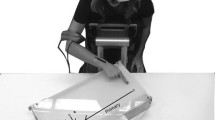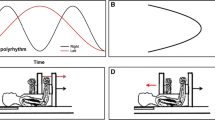Abstract
Proprioception is used by the central nervous system (CNS) in the control of the spatial and temporal characteristics of single joint and multiple joint movement. The present study addressed the role of proprioception in the control of bilateral cyclical movements of the limbs. Normal blindfolded human subjects drew circles simultaneously and symmetrically with the two arms (16 cm diameter, 1 /s) upon two digitizing tablets. In selected trials, vibration (60–70 Hz) was applied to the tendon of the biceps and/or anterior deltoid muscles of the dominant arm to distort the proprioceptive information from muscle spindle afferents. One goal of this study was to identify whether tendon vibration influenced the spatial characteristics of circles drawn by the vibrated, dominant arm and the non-vibrated, non-dominant arm. A second goal was to determine the effect of vibration on the temporal coupling between the two arms during circle drawing. The results revealed that tendon vibration affected the spatial characteristics of circles drawn by the vibrated arm in a manner similar to that previously found for unilateral circle drawing. During bimanual circle drawing, vibration had only a minimal effect on the spatial characteristics of the non-vibrated, non-dominant arm. Temporal interlimb coupling was quantified by the relative phasing between the arms. Without tendon vibration, the dominant arm led the non-dominant arm. Vibration of the dominant arm increased the average phase lead. In a first control experiment, vibration of the non-dominant arm decreased the phase lead of the dominant arm, or even reversed it to a non-dominant arm phase lead. In a second control experiment, the subjects performed the bimanual circle-drawing task with vision of only the vibrated arm, in which case there was no spatial distortion of the circles drawn by the vibrated arm, but the phase relation between the two arms was still shifted as if vision were completely unavailable. It was concluded that, in bimanual movements such as these, the spatial and temporal characteristics of movement are controlled independently. Whereas the spatial characteristics of hand movement seem to be controlled unilaterally, the temporal characteristics of interlimb coupling appear to be controlled by proprioceptive information from both limbs, possibly by a proprioceptive triggering mechanism.
Similar content being viewed by others
Author information
Authors and Affiliations
Additional information
Received: 29 November 1997 / Accepted: 16 February 1999
Rights and permissions
About this article
Cite this article
Verschueren, S., Swinnen, S., Cordo, P. et al. Proprioceptive control of multijoint movement: bimanual circle drawing. Exp Brain Res 127, 182–192 (1999). https://doi.org/10.1007/s002210050788
Issue Date:
DOI: https://doi.org/10.1007/s002210050788




